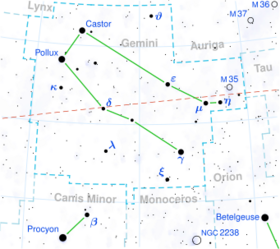Astronomy:57 Geminorum
|-
! style="text-align: center; background-color: #FFFFC0;" colspan="2" | Observation data
Equinox J2000.0]] (ICRS)
|- style="vertical-align:top"
! style="text-align:left" | Constellation
| Gemini
|- style="vertical-align:top"
|- style="vertical-align:top" ! style="text-align:left" | Right ascension | 07h 23m 28.511s[1] |- style="vertical-align:top" ! style="text-align:left" | Declination | +25° 03′ 01.91″[1] |- style="vertical-align:top" ! style="text-align:left" | Apparent magnitude (V) | 5.018[2]
|- ! style="background-color: #FFFFC0; text-align: center;" colspan="2"| Characteristics |-
|-
|- style="vertical-align:top"
|- style="vertical-align:top" ! style="text-align:left" | Spectral type | G8III[3] |- style="vertical-align:top"
|- style="vertical-align:top"
|- style="vertical-align:top"
|- style="vertical-align:top"
|- style="vertical-align:top"
|- style="vertical-align:top"
|- style="vertical-align:top"
|- style="vertical-align:top"
|- style="vertical-align:top" ! style="text-align:left" | U−B color index | +1.778[2] |- style="vertical-align:top" ! style="text-align:left" | B−V color index | +0.174[2] |- style="vertical-align:top"
|- style="vertical-align:top"
|- style="vertical-align:top"
|- style="vertical-align:top"
|- style="vertical-align:top"
|- style="vertical-align:top"
|- style="vertical-align:top"
|- style="vertical-align:top"
|- style="vertical-align:top"
|- style="vertical-align:top"
|- style="vertical-align:top"
|- style="vertical-align:top"
|- style="vertical-align:top"
|- style="vertical-align:top"
|- style="vertical-align:top"
|- style="vertical-align:top"
|- style="vertical-align:top"
|- style="vertical-align:top"
|- style="vertical-align:top"
|- style="vertical-align:top"
|- style="vertical-align:top"
|- style="vertical-align:top"
|- style="vertical-align:top"
AstrometryRadial velocity (Rv)5.43±0.13[1] km/sProper motion (μ) RA: −66.676[1] mas/yr
Dec.: −29.082[1] mas/yr Parallax (π)18.1774 ± 0.1459[1] masDistance179 ± 1 ly
(55.0 ± 0.4 pc)Absolute magnitude (MV)1.66[4]
DetailsMass2.2[5] M☉Radius7.1[1] R☉Luminosity29[1] L☉Surface gravity (log g)2.84[4] cgsTemperature4,902[4] KMetallicity [Fe/H]0.21[4] dexRotational velocity (v sin i)1.3[6] km/sAge1.2[7] Gyr
Other designations
|}
57 Geminorum (57 Gem) is a yellow giant star in the constellation Gemini, with an apparent magnitude of 5.0. At a distance of about 179 light years, it has a luminosity about 29 times the Sun's. With an age of about 1.2 billion years, it has evolved away from the main sequence and expanded to seven times the width of the Sun.
57 Geminorum is the star's Flamsteed designation. It also has the rarely-used Bayer designation A Geminorum.
The radial velocity of 57 Geminorum has been closely examined for indications that it may have orbiting exoplanets, but it shows a particularly stable radial velocity.[8][9]
References
- ↑ 1.0 1.1 1.2 1.3 1.4 1.5 1.6 1.7 Vallenari, A. et al. (2022). "Gaia Data Release 3. Summary of the content and survey properties". Astronomy & Astrophysics. doi:10.1051/0004-6361/202243940 Gaia DR3 record for this source at VizieR.
- ↑ 2.0 2.1 2.2 Paunzen, E. (2022). "Catalogue of stars measured in the Geneva seven-colour photometric system". Astronomy and Astrophysics 661: A89. doi:10.1051/0004-6361/202142355. Bibcode: 2022A&A...661A..89P.
- ↑ Harlan, E. A. (September 1969). "Mk classifications for F and G-type stars". Astronomical Journal 74: 916. doi:10.1086/110881. Bibcode: 1969AJ.....74..916H.
- ↑ 4.0 4.1 4.2 4.3 Schiavon, Ricardo P. (July 2007). "Population Synthesis in the Blue. IV. Accurate Model Predictions for Lick Indices and UBV Colors in Single Stellar Populations". The Astrophysical Journal Supplement Series 171 (1): 146–205. doi:10.1086/511753. Bibcode: 2007ApJS..171..146S.
- ↑ Queiroz, A. B. A.; Anders, F.; Chiappini, C.; Khalatyan, A.; Santiago, B. X.; Steinmetz, M.; Valentini, M.; Miglio, A. et al. (2020). "From the bulge to the outer disc: StarHorse stellar parameters, distances, and extinctions for stars in APOGEE DR16 and other spectroscopic surveys". Astronomy and Astrophysics 638: A76. doi:10.1051/0004-6361/201937364. Bibcode: 2020A&A...638A..76Q.
- ↑ Glebocki, R.; Gnacinski, P. (2005). "VizieR Online Data Catalog: Catalog of Stellar Rotational Velocities (Glebocki+ 2005)". VizieR On-line Data Catalog: III/244. Originally Published in: 2005csss...13..571G; 2005yCat.3244....0G 3244. Bibcode: 2005yCat.3244....0G.
- ↑ Takeda, Yoichi et al. (August 2008). "Stellar parameters and elemental abundances of late-G giants". Publications of the Astronomical Society of Japan 60 (4): 781–802. doi:10.1093/pasj/60.4.781. Bibcode: 2008PASJ...60..781T.
- ↑ Sato (2005). "Radial-Velocity Variability of G-Type Giants: First Three Years of the Okayama Planet Search Program". Publications of the Astronomical Society of Japan 57 (1): 97–107. doi:10.1093/pasj/57.1.97. Bibcode: 2005PASJ...57...97S.
- ↑ Isaacson, Howard (2010). "Chromospheric Activity and Jitter Measurements for 2630 Stars on the California Planet Search". The Astrophysical Journal 725 (1): 875–885. doi:10.1088/0004-637X/725/1/875. Bibcode: 2010ApJ...725..875I.
 |


